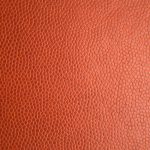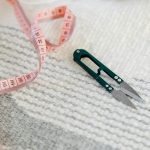When sewing with bouclé fabric, handle it gently to protect its looped texture and prevent snagging. Use sharp scissors or rotary cutters to cut clean edges, and choose a universal needle size 70/10 or 80/12 with polyester thread for durability. Pin carefully and sew with a longer stitch length, employing a walking foot to avoid shifting. Finish seams with a serger or bias tape to minimize fraying. If you want to master every step, keep exploring proven techniques for flawless results.
Table of Contents
Key Takeaways
- Prepare bouclé by gently pressing with low heat and securing pattern pieces with fine pins or weights to prevent distortion.
- Use sharp universal needles (70/10 or 80/12) and polyester thread for smooth stitching without snags.
- Cut slowly with sharp scissors or rotary cutters, leaving extra fabric for trimming and applying fray preventer on raw edges.
- Sew with longer straight stitches (3–3.5 mm) using a walking foot to feed fabric evenly and avoid puckering.
- Finish seams with a serger or bias tape, press gently with a cloth, and care for garments by hand washing and drying flat.
Understanding Bouclé Fabric Characteristics
Bouclé fabric features a distinctive looped texture that gives it a unique, nubby surface. When you work with bouclé, you’ll notice its uneven yarns create a tactile, textured feel that adds depth and interest to your projects.
This fabric tends to be thick and can be somewhat bulky, so it’s crucial to take into account its weight and drape when planning your garment or accessory. You’ll also find that bouclé often contains a mix of fibers like wool, cotton, or synthetic blends, which influence its stretch and durability.
Because of its loops and texture, bouclé can snag easily, so handle it gently during cutting and sewing. Understanding these characteristics helps you prepare for its challenges and guarantees your final piece looks polished and professional.
Essential Tools for Sewing Bouclé
To sew bouclé fabric effectively, you’ll need the right tools for the job.
Choosing the correct needle and thread can prevent snags and guarantee strong seams, while sharp cutting tools help maintain the fabric’s texture.
Let’s explore which tools work best to handle bouclé with care.
Needle Types
Although sewing with textured fabrics can be challenging, choosing the right needle makes a significant difference when working with bouclé.
You’ll want to use a sharp or universal needle, typically size 70/10 or 80/12, to smoothly penetrate the loops without snagging. A ballpoint needle isn’t ideal here since it can push fibers aside rather than cut through, causing uneven stitches.
If your bouclé has a heavy weave, consider a denim or topstitch needle for extra strength. Always replace dull needles to prevent skipped stitches or fabric damage.
Thread Selection
When you choose thread for sewing bouclé, you need one that’s strong enough to handle the fabric’s texture without breaking or blending in too much.
Polyester thread is an excellent choice because it offers strength and slight elasticity, which accommodates bouclé’s uneven surface. Pick a thread color that complements your fabric—either matching closely or providing a subtle contrast to highlight your stitches.
Avoid lightweight or fine threads, as they can snap under the fabric’s tension. Also, steer clear of overly thick threads; they may cause bulky seams and snag on bouclé’s loops.
Using a good-quality, medium-weight polyester thread guarantees your seams hold up well and your sewing looks clean and professional on this unique, textured fabric.
Cutting Tools
Choosing the right cutting tools is essential for working smoothly with bouclé fabric. You’ll want sharp, high-quality scissors or a rotary cutter to handle its textured surface without snagging. Regular fabric scissors may struggle, so invest in ones dedicated to bouclé or heavy fabrics.
A rotary cutter paired with a self-healing mat offers clean, precise cuts, especially helpful for straight edges. Avoid dull blades, as they can pull loops and distort the fabric.
Also, consider using fine, sharp pins or fabric clips to keep layers stable while cutting. Taking these precautions will help you achieve accurate pattern pieces and reduce fraying, making your sewing process much easier and your finished garment look professional.
Preparing Bouclé Fabric for Cutting
Before you start cutting bouclé fabric, you’ll want to prepare it carefully to assure clean edges and accurate pieces.
Begin by gently pressing the fabric with a low-heat iron, using a pressing cloth to prevent snagging the loops. This flattens the texture without damaging it.
Next, lay the fabric on a clean, flat surface, smoothing out any wrinkles or folds. Because bouclé has a loose weave, consider letting it rest after unrolling to reduce distortion.
Pin your pattern pieces securely, using fine pins placed parallel to the cutting line to avoid shifting. If your fabric tends to fray, you might want to apply a light fabric stabilizer or use pattern weights instead of excessive pinning.
Taking these steps assures your cuts will be precise and your project successful.
Selecting the Right Sewing Needle and Thread
When working with bouclé fabric, choosing the right needle and thread is essential to avoid snags and guarantee smooth stitching.
You’ll want to pick needle types designed for textured, looped fibers and thread that complements the fabric’s weight and texture.
Matching your needle and thread carefully will help your project come together flawlessly.
Needle Types for Bouclé
You’ll want to use a needle specifically designed for textured fabrics when sewing bouclé to prevent snagging and skipped stitches.
A universal needle in size 80/12 or 90/14 usually works well, but you might find a ballpoint or stretch needle better if your bouclé has knit elements. These needles have rounded tips that slide between fibers rather than piercing them, preserving the fabric’s loops.
Avoid sharp or heavy-duty needles, as they can damage bouclé’s delicate texture. Also, consider using a new needle to guarantee smooth stitching. Changing needles regularly helps maintain stitch quality and reduces fabric wear.
Thread Choices Explained
Choosing the right thread is just as important as picking the correct needle for sewing bouclé fabric.
You’ll want to select a thread that’s strong yet flexible to handle bouclé’s textured weave without breaking. Polyester thread is a reliable choice because it offers durability and slight stretch, perfect for bouclé’s loops and curls.
Avoid cotton threads since they can snap under tension and lack the elasticity needed. Also, consider thread weight: a medium-weight thread works best to blend smoothly without overpowering the fabric’s texture.
When threading your machine, make certain the thread moves smoothly through the guides to prevent snags.
Selecting the right thread guarantees your stitches hold firmly and your finished project looks clean and professional.
Matching Needle and Thread
Selecting the right combination of needle and thread is essential for sewing bouclé fabric smoothly and securely. You’ll want to use a sharp or universal needle size 80/12 or 90/14 to easily penetrate the textured fibers without causing snags. For thread, choose a strong polyester or cotton-wrapped polyester thread that matches your fabric’s weight and color. Avoid bulky threads as they can get caught in the loops.
| Needle Type | Size Range | Best Use |
|---|---|---|
| Universal | 80/12-90/14 | General sewing, bouclé fabric |
| Sharp | 80/12 | Piercing dense textures |
| Ballpoint | Not recommended | Avoids snagging threads |
| Denim | 90/14 | Thick bouclé layers |
| Embroidery | 75/11 | Decorative stitching only |
This combination guarantees clean stitches and durable seams.
Cutting Techniques to Prevent Fraying
Because bouclé fabric has a loose, looped weave, it tends to fray easily when cut. To minimize fraying, use sharp fabric scissors or a rotary cutter for clean, precise edges. Cut slowly and steadily to avoid pulling loops and distorting the fabric.
Consider cutting each piece slightly larger than your pattern to allow for trimming after initial stitching. You can also apply a thin line of fray-preventing liquid along raw edges right after cutting, but test it on a scrap first to guarantee it won’t stiffen the fabric.
When possible, cut on the bias to reduce fraying and increase fabric stability. Finally, avoid excessive handling of cut edges before sewing to keep loops intact and prevent unraveling.
Stitching Tips for Seam Stability
When you sew bouclé fabric, maintaining seam stability is essential due to its textured loops and loose weave. To keep your seams strong, use a straight stitch with a slightly longer stitch length—around 3 to 3.5 mm—to avoid puckering.
Reinforce stress points by backstitching at the beginning and end of each seam. Consider using a fine needle, like a size 70/10 or 80/12, to prevent snagging the loops. You might also want to use a walking foot to feed the fabric evenly, reducing shifting.
Pin your pieces carefully but avoid over-pinning, which can distort the fabric. Ultimately, press your seams gently with a pressing cloth to avoid crushing the texture while setting the stitches for a clean, stable finish.
Finishing Edges and Seams on Bouclé
You’ll often find that finishing edges and seams on bouclé requires extra care to prevent fraying and maintain the fabric’s unique texture.
Given bouclé’s loose weave and loops, simple seam finishes won’t do. You need techniques that secure edges without flattening the fabric’s characteristic volume.
Here are five effective methods to finish bouclé seams:
- Use a serger or overlock stitch to neatly encase raw edges.
- Apply bias tape for a clean, sturdy finish.
- Try pinking shears to reduce fraying on less visible seams.
- Hand-stitch a catch stitch for delicate edges.
- Press seams gently with a cloth to avoid crushing loops.
Caring for Finished Bouclé Garments
Although bouclé fabric adds a luxurious texture to your garments, caring for them demands gentle handling to preserve their softness and prevent damage. Always hand wash or use a delicate cycle with cold water. Avoid wringing; instead, press out water gently and lay flat to dry. Store your bouclé pieces folded or on padded hangers to maintain their shape and texture.
| Care Aspect | Recommended Method | What to Avoid |
|---|---|---|
| Washing | Hand wash or delicate cold | Hot water or machine wash |
| Drying | Lay flat, air dry | Tumble drying |
| Storage | Fold or padded hangers | Wire hangers |
| Ironing | Low heat, pressing cloth | Direct high heat |
Following these tips helps your bouclé garments stay beautiful and last longer.
Frequently Asked Questions
Can Bouclé Fabric Be Used for Upholstery Projects?
You can definitely use bouclé fabric for upholstery projects. It offers a textured, cozy look but be sure to choose a durable weave and reinforce seams since bouclé’s loops might snag or wear out with heavy use.
Is Bouclé Fabric Suitable for Summer Clothing?
Think of bouclé fabric as a cozy cloud—it’s generally too warm and textured for summer clothing. You’ll want lighter, breathable fabrics for hot days to stay comfortable and avoid overheating in this cozy, nubby material.
Where Can I Buy High-Quality Bouclé Fabric?
You can buy high-quality bouclé fabric from specialty fabric stores, online marketplaces like Etsy and Fabric.com, or luxury textile shops. Always check reviews and request fabric swatches to guarantee it meets your standards before purchasing.
How Does Bouclé Fabric Compare to Tweed?
You’ll find bouclé fabric softer and loopier, with a textured, curly surface. Tweed’s denser and rougher, often woven with multicolored yarns. Both are durable, but bouclé feels lighter and more delicate compared to tweed.
Can Bouclé Fabric Be Machine Washed Safely?
Think of bouclé like your favorite delicate sweater—machine washing can be risky. You shouldn’t machine wash bouclé fabric; instead, opt for gentle hand washing or dry cleaning to keep its texture and shape intact.
- Does Chiffon Fabric Stink - July 15, 2025
- Does Chiffon Fabric Affect the Economy - July 15, 2025
- Does Cotton Fabric Have a Nap - July 15, 2025







